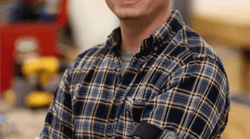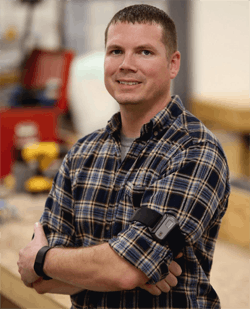A prescriptive analytics approach to safety
Gabriel Glynn is co-founder and CEO of MākuSafe, a Des Moines, IA-based startup that looks to apply prescriptive analytics to plant worker safety. A software specialist who’s the son of a plant safety manager, Glynn says he witnessed first-hand the stress created by OSHA safety audits during plant visits he has made across the country as host of the Advanced Manufacturing podcast. Aiming to help plants be more proactive rather than reactive when it comes to safety, he developed a thumb-size device that workers can wear in an armband to track and analyze falls, slips, near-misses, and more.
PS: What led you to decide that manufacturing needed a more tech-centric approach to keeping workers safe?
GG: I started asking people in the industry, “How do you guys monitor environmental conditions?” and “What other types of things in the environment can impact workers’ safety?” and “What things are governed by laws and rules and regulations?” And really what emerged was this process that was seemingly pretty outdated and ripe for disruption.
They pay thousands of dollars to have companies come in on an annual basis and take a snapshot of what’s going on in the environment in the facility, and then they just kind of assume that the other 364 days, things are going to maintain that level. And we know that the nature of the environment is always changing. That was when I approached my co-founder, Mark Frederick – he has a lot of experience in IoT and cloud computing and building devices – and I said to him, I think there’s a significant opportunity here to really change the way that the world looks at workplace environments and how we monitor environmental conditions and exposures and how they really impact (employees’) health and happiness and safety.
PS: How does the MākuSafe device work, and what metrics are you tracking?
GG: There’s really two components to the wearable itself. There’s an armband, and then there’s what we call the device core. The device core sits in a charging station, which holds 20 cores. When an employee comes in for their shift, it assigns them a device from the base station. They put that into their armband; they spend the day going through their shift, and it’s constantly sending data back to that platform on what’s being detected in the environment around them or what’s being identified by the employee themselves. We’re tracking things like temperature levels, ambient lighting, sound levels. We (can calculate) the full time-weighted average of what an employee’s being exposed to during their shift. We’re also tracking things like air quality, using a TVOC (total volatile organic compound) sensor, and then we’re tracking things like movement – slips, trips, and falls in a facility and their location. We know exactly where in a facility these incidents are taking place. I tell people, we’re not tracking how many bathroom breaks people are taking, but if they trip in the bathroom, we’ll know.
PS: What has surprised workers or management about results?
GG: One of the early beta tests that we did, we met with the factory manager, and he’s got a small facility, around 50 employees. It’s a metal fabrication shop. And he made the comment, “I can’t wait to put these on some people, because I’ve got a couple of people who tend to be the problem in our facility…It’ll be really interesting to see what we uncover.” What was interesting was discovering was that these people worked in areas that are significantly lower in lighting and are exposed to significantly higher levels of sound than people in other areas of the facility. So what that brings to light is that it’s not always necessarily the worker that’s the problem; it could be a combination of environmental factors that are leading to the problems that they’re having.
When you talk about the shortage of employees and the importance of maintaining a healthy, happy, and safe workforce, these factories just can’t afford to lose somebody to a time-off incident. So this provides optics into things that they maybe never had optics into, and an understanding of what conditions could be impacting not only workers’ safety but certainly their happiness and their contentness with their job. Why wait until there’s claims before we start to provide specific and prescriptive resources? Let’s use the data to say, hey, here are some challenges we’re starting to see creep up, and your insurance carrier has some resources to help you resolve that before it even becomes an issue.


